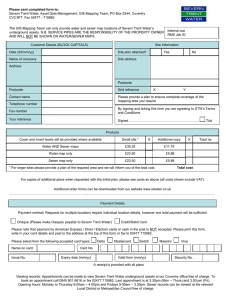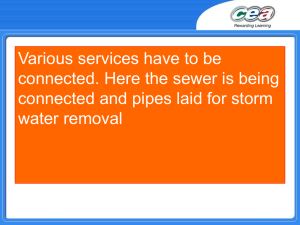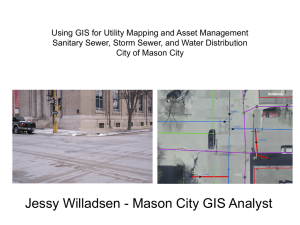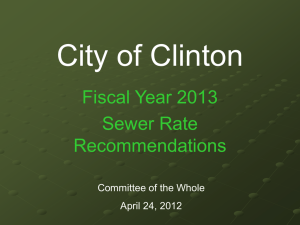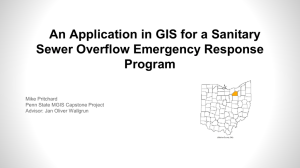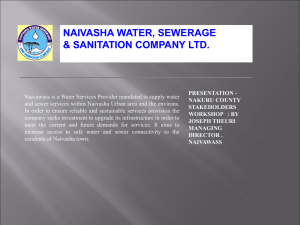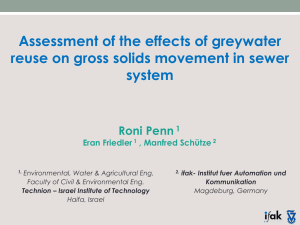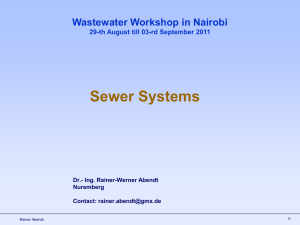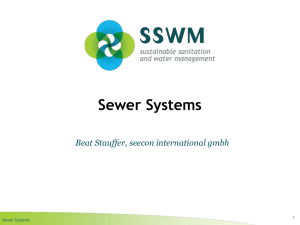The Direction of SSO Enforcement and How to Prepare for
advertisement
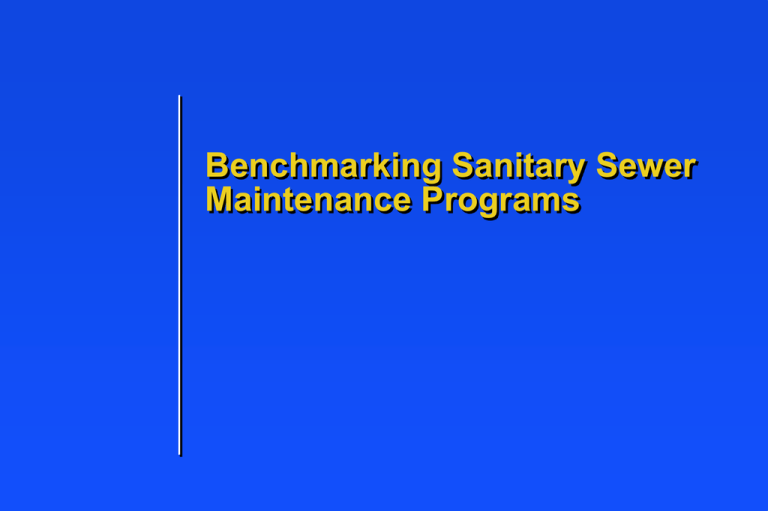
Benchmarking Sanitary Sewer Maintenance Programs Benchmarking is … “the practice of being humble enough to admit someone is better than you at something and then being wise enough to learn to match and even surpass them at it.” (Harmon, 1992) A Benchmarking Program Will Provide Multiple Benefits to System Operators and Managers Defines performance and cost indicators by which a program can be compared to similar utilities and industry standards Helps identify and examine areas within a program where changes may improve performance such as staffing, equipment, organization, and efficiency. Illustrates improvement potential and provides standards on which to base performance goals Provides a basis to track improvements in performance over time and document the benefits of changes The Benchmarking Process is a Cycle of Continuous Evaluation and Improvement Implement Change Evaluate Goals Identify Areas for Improvement Collect Data Consider Explanatory Factors Document Success YES Goals Met? NO Benchmarking Improves the Effectiveness of a Sanitary Sewer Maintenance Program to Meet Community Objectives Protect public from exposure to disease-causing organisms Protect property and homes against damage Protect environment and water quality Protect public’s large capital investment in the sanitary sewer system Protect utility from regulatory actions Survey Data Related to a Wide Range of Sanitary Sewer Maintenance Issues General System Information – length of sewers, number of pump stations Equipment and Labor Indicators – numbers and types of equipment – number of collection system staff Budget Indicators – preventive vs. emergency maintenance Performance Indicators – stoppages per year – overflows per year – odor complaints per year The Top 8 Performers (Based on Low Cost and Low Stoppages) Were Used for Comparisons Low Cost High Cost Top 8 Performers Low Stoppages High Stoppages System Characteristics Should Mimic the System Being Benchmarked as Closely as Possible 24.3 Average Age (years) 39.3 33.1 Minimum Maximum Average 450 Total Length (miles) 2,445 1,100 72,000 Population 458,400 200,000 0% 50% 100% 150% Percent of Average Value 200% 250% Budget Indicators Can Be Difficult to Compare Between Systems, But Are Helpful as Relative Guides $9.20 $27.09 Sewer Bill $/mo. $15.83 34% PM/Total Maintenance, % 90% 55% $1,473/mile O&M Budget/mile $4,107/mile $3,070/mile $6.25 $7.37 $6.90 Labor I, $/hr 0% 50% 100% 150% Percent of Average Value Minimum Maximum Average 200% Staffing and Equipment Indicators Are Useful for Preparing and Defending Annual O&M Budgets 30% Equip. System Clean Capacity 52% 42% 0.00 3.40 FMs/100 miles 1.4 0.91 Pipe Emp./100 miles of sewer 4.07 3.1 0.06 Pipe Emp./1000 Pop. 0.27 0.17 Minimum Maximum Average 0.08 0.22 Employees/PS 0.16 0% 50% 100% 150% Percent of Average Value 200% 250% The Top 8 Benchmarking Performers Are Approaching Private Preventive Maintenance Budget Percentages Private Avg. Public Avg. Emergency Preventive Top 8 0% 20% 40% 60% 80% Cost/mile/year The Least-Cost Maintenance Program Contains a Mix of Preventive and Emergency Maintenance Approaches Total Maintenance Emergency Maintenance Preventive Maintenance Overflows or Stoppages/mile of sewer/year Converting to a Preventive Maintenance Program May Take Several Years Before Total Maintenance Budget Decreases Cost/mile/year Total Maintenance Preventive Maintenance Emergency Maintenance Time, years The Percentage of Maximum Cleaning Capacity Achieved Provided an Indication of the Efficiency of Crews Cleaning efficiency equals percent of system cleaned divided by maximum cleaning capacity Max cleaning capacity determined by standard cleaning rates: – hydraulic = 2,000 ft/day % of Max Cleaning Capacity 120% 100% 80% 60% 40% – power rod = 1,800 ft/day 20% – manual rod = 900 ft/day 0% Min Max Avg Performance Indicators Show the Overall Effectiveness of a Sewer Maintenance Program 3.0 Odor Comp./100 miles 9.9 5.2 Minimum Maximum Average 0.02 MH OFs/mile of sewer 0.25 0.10 0.03 Blockages per mile of sewer 0.42 0.23 0% 50% 100% 150% 200% Percent of Average Value 250% 300% Cost-Effective Performance Was Determined by a Combination of Cost and Performance Indicators 38 Overflows/mi * $ O&M/mi 378 229 Minimum Maximum Average 64 Stoppages/mi * $ O&M/mi 1,300 621 0% 50% 100% 150% Percent of Average Value 200% 250% A Range of Beneficial Conclusions or Recommendations May Result from a Benchmarking Study Changes in staffing or equipment needs to improve efficiency and meet performance goals Changes in department policies or practices: – appraisal practices, pay scales, partnering, employee utilization, outsourcing – root and grease control programs Establishment of performance goals – percentage of system cleaned per year – percentage of system rehabilitated per year – reductions in overflows and stoppages A Benchmarking Program Provides a Basis for Tracking Cost & Performance to Show the Benefits of Improvements Performance and cost indicators are defined Staffing, equipment, organizational factors may be identified and examined to improve performance and efficiency Comparisons to other similar systems and good performers identifies areas of potential improvement Performance goals are tracked over time to show improvements from implemented changes
